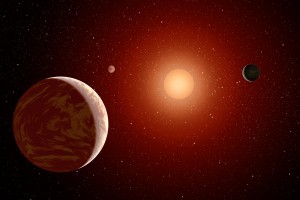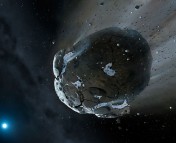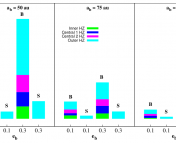
Artist’s illustration of planets orbiting an M-dwarf star (NASA/JPL-Caltech).
Title: Habitable Evaporated Cores: Transforming Mini-Neptunes into Super-Earths in the Habitable Zones of M Dwarfs
Authors: Rodrigo Luger, Rory Barnes, Eric Lopez, Jonathan Fortney, Brian Jackson, Victoria Meadows
First Author’s Institution: University of Washington Astronomy Department & Virtual Planetary Laboratory
Status: published in Astrobiology
M-dwarf stars are a great place to look for habitable planets. Since these stars aren’t very luminous, their habitable zones (HZs) are very close-in—a tenth or less of Earth’s distance from our sun—which means frequent and easy-to-spot orbits via the transit method. M-dwarfs’ low mass means that Earth-mass planets are easier to spot than around more massive stars, too, since they can have a more pronounced effect via the radial velocity method, too.
There are downsides to trying to live around an M-dwarf, though: low mass for a star means slower evolution, which means a longer time in the violent, hyperactive phases of stellar youth. A terrestrial planet present for those flares and bombardment could be sterilized. And besides, a planet that would form as close in as an M-dwarf’s habitable zone would likely be very small, less than a third of Earth’s mass, and very dry, since water and the volatile compounds that make a rocky planet habitable are mostly found farther out in the protoplanetary disk when planets are forming. No matter how perfect your level of insolation, small, dry, and sterilized does not a habitable planet make.
But wait. We know that planets don’t have to form where they end up. Disk-driven migration and planet-interaction scattering events can pull planets from more distant formation locations into narrow paths around their stars. (That’s the going theory for all those hot Jupiters.) Today’s paper looks not at whether an Earth-like planet could migrate into the habitable zone of an M-dwarf, but instead at whether a Neptune-like planet could migrate in and, perhaps, in the process, become Earth-like somehow.
The authors of this paper investigate whether the properties of an M-dwarf that might make it inhospitable could also give it transformative powers over a Neptune that got drawn in close. Could the star’s gravity and violence strip away a planet’s thick atmosphere, or envelope, to reveal a habitable core?
Short answer: in many cases, yes! Long answer: there are many considerations. The interactions between migration, tidal forces, orbital eccentricity, planetary mass, planetary radius, stellar luminosity, and stellar activity over time are not only incredibly complex but also not yet fully understood. (If you’re interested in the specifics, I strongly recommend checking out the paper itself. Complexities of planet-modeling aside, the authors also do a lovely and thorough job of explaining, assessing, and building on many strands of prior research, Burke’s “parlor” in action.)
The primary forces that could strip a Neptune of its core are gravity and heat. When a planet migrates in toward its star, both of these forces, coming from the star, affect it more strongly (heat by way of stellar radiation). On the gravity front, the planet’s Roche lobe becomes smaller. (Roche lobe term usually applies to binary stars, but works for our planet-star system here as well.) This means that the planet’s area of gravitational influence contracts: gas that once was bound to the planet no longer is. Whoosh.
By the time a Neptune gets to an M-dwarf’s habitable zone, then, it’s already lost a good deal of its envelope. And then it’s all up close to the star’s potentially violent business: extreme ultra-violet radiation, or XUV, can heat the atmosphere so powerfully that rather than individual atoms just heating up and flitting away, per Jeans escape, whole chunks of the atmosphere blow off at once. In this XUV blow-off mechanism, heating leads to expansion of the outer envelope, accelerating light ions to supersonic speeds. If the gas velocity exceeds the planet’s escape velocity, it escapes en masse, taking heavier molecules with it.
That’s the model, but whether or not these mechanisms will strip a planet of its entire envelope depends on many factors, some of which are unknown. For example, M-dwarf evolution has not been studied enough to be settled. If an M-dwarf emits powerfully in the XUV range, then it could fully evaporate a Neptune’s gas envelope. But if its emissions skew more toward X-rays? Our Neptune won’t have as good a chance.
Other variables in this complex system are better known but are still variable. The authors of this paper tested many, many variables and relationships to see if this process is possible and they found that, yes, often enough, it probably is. The sweet spot: a planet with a rocky core of a bit less than Earth’s mass and a gaseous envelope of about the same mass of hydrogen and helium migrates early in the course of planet formation to the inner habitable zone of an M-dwarf that emits a lot of XUV radiation. This means that super-Earths in the HZs of M-dwarfs aren’t likely to be the evaporated cores of former Neptunes. They more likely formed in situ, which means that even if they’re big, they’re likely dry and even sterilized. But Earth-mass planets in M-dwarfs’ HZs stand a chance of having once migrated in, and though they’ve lost their gaseous envelopes, they may have held onto their water and interesting chemistries and could be home to, possibly, just maybe, life.





Fascinating idea, figuring out that it may be possible for a Neptune sized planet to migrate into the habitable zone of an M-dwarf and retain its water content. I’d be interested to know how many known transiting exoplanets around M-dwarfs are of the correct mass and radius from the star to potentially be one of these migrated Neptune-sized planets.
This is very interesting. Could this potentially mean that some of the Earth-like planets we’ve found outside the habitable zone could migrate into it in the future? Or do we understand most of these systems to be stable and no longer migrating?
How often to planets migrate when they are forming? Is there any way to know whether the planets in our solar system have migrated?
Hi Jaime, this is really interesting. It actually made me wonder about the history of our own Solar System. Although it seems like we know quite a bit about the migration patterns of Jupiter and Saturn, there are still a few things that (to my knowledge) scientists still haven’t perfected. One example is the formation of Earth’s moon – configuring the mass distribution and momentum of the Earth/Moon system is a puzzle we haven’t quite solved yet. Do you think this could have been more greatly affected by (bizarre) migration patterns than we previously imagined?
I understand that planet migration can be modeled, but how can we empirically know for certain that such migration occurred as predicted by theory? Are models accounting for the current locations of objects in our solar system and others sufficient without additional testing?
Fascinating! I wonder how different the story is with white dwarfs. Could Neptune-like planets which survive the giant phase of the star migrate in and become super-Earths?
Perfect clarification